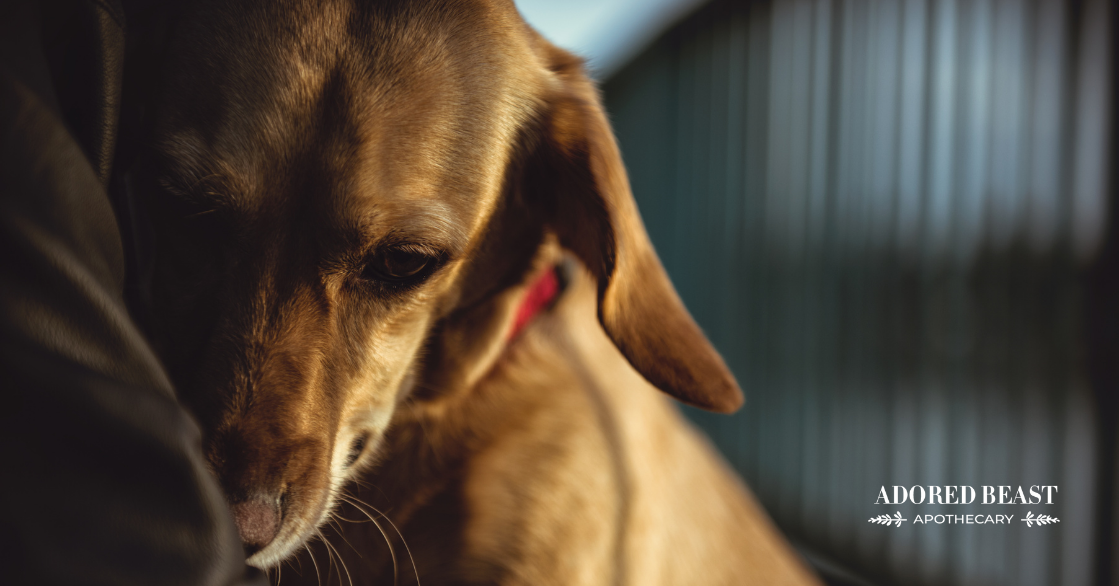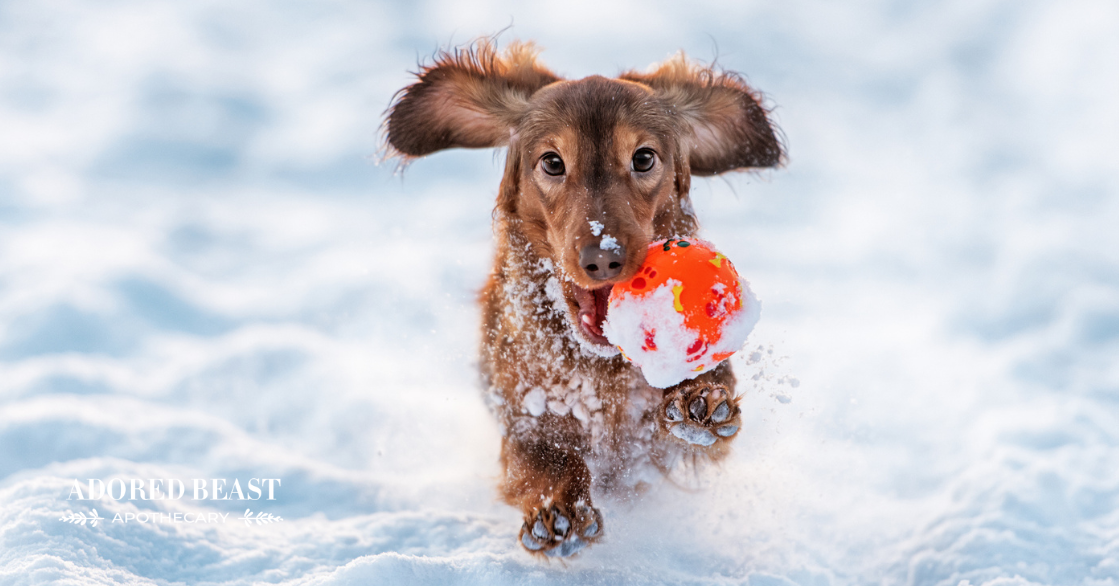Vomiting in dogs has a wide range of causes. Thankfully, it can be really easy to deal with – but it can also be life-threatening.
I want to start by saying that, depending on what causes the vomiting, it should resolve quickly. It comes, you react accordingly, and it should stop soon after. If it doesn’t, you need to go to the vet.
IMPORTANT: If there’s even a 1% chance that your dog has swallowed a foreign object or gotten into chemicals or something toxic, you need to go to the vet immediately! Staggering, lethargy, wobbling, in distress while vomiting, or blood in the vomit are all signs to seek emergency veterinary care!!
In this post, I’m going to try and help you figure out what is what. Knowing the cause is essential in picking the right course of action. But please remember, the best thing you can do if you’re not sure about the cause, if it’s long-lasting, or if you are just concerned about it at all, is to take your animal to the vet.
What Causes Vomiting in Dogs?
I would say the most common cause is a dog eating something they shouldn’t, getting into something that’s not agreeing with them.
A note to start: Lots of times dogs will eat grass and not throw up – they just want fiber or something live. But if your dog goes out and eats grass and then comes in and vomits, that’s usually a sign of something deeper going on. If your dog is frantic to eat grass, pawing at the door in a mad rush to get outside, then heading for the biggest patch of grass they can find, think of it like you needing an antacid. They’re using the grass to help calm stomach pain, acid reflux, or nausea.
And if your dog eats grass, they shouldn’t be throwing it up, at least not a lot of it. (Unless of course the grass has been treated with chemical sprays – that alone can cause vomiting in dogs). They should be able to digest it, and then you’ll see it come out in their poop.
For more about grass eating, read this post.
Ok, back to some of the most common causes…
1. Getting into the Garbage/Something Toxic
With garbage, we always have to worry about if there was something toxic in there. Is there a possibility of there being something like a household cleaner or chemical (could have spilt on the food they ate) or a piece of plastic or something else that’s indigestible (milk cartons)? Any of these things can not only cause vomiting in dogs, but also blockages or liver and kidney failure as well, which can all be fatal.
ALWAYS BREAK BREAD TAGS! That means any tabs that come of bread bags, milk bags, baked treats, etc. These adhere to the gut wall and create a blockage. That can also get stuck on bird beaks and the birds starve to death. Cut them in half.
If your dog gets into someone else’s garbage you need to dig in and investigate. Go through that garbage and see what’s in it. Look for wrappers (chocolate), containers (poisonous substances), etc. That way you can go to the vet and say “this was in there” so that your vet can choose the appropriate treatment based on what your dog has eaten.
What are other ways your dog can get into something toxic that would cause vomiting?
- Did you just use a cleaner on the floor or fabric spray on the couch?
- Did you bleach your dog’s bowl and not rinse it well enough?
- Did they lick bug spray off your legs or arms?
- Did they eat something with xylitol in it (mints, chewing gum)?
- Did they get into some marijuana?
- Have they eaten a dead animal? Could that animal have been poisoned?
Think hard about what possible contaminants could be in their body.
2. Pancreatitis
I used to see this at my clinic all the time. Counter surfing, kids feeding the dog or dropping food from their highchairs. Kids think it’s amazingly funny, but as cute as it may be, it’s not good for dogs, especially those with sensitive stomachs. And sometimes, depending on what the child is eating, it could be harmful.
This is especially true with fatty foods. If a dog jumps up on the counter and steals a cooked chicken with lots of fat on it, or gets up and licks bacon grease out of a frying pan, that can cause pancreatitis. If they start to throw up after something like this, it’s a clear path to pancreatitis – an overdose of fat. In this case, it’s always a good idea to go to the vet right away.
Stress can also cause pancreatitis (it can cause so many illnesses, truly), so if you’re noticing anything – any kind of emotional change or upset in the house, in your dog’s life, someone leaving to go off to school, a divorce, anything that could potentially upset them – and vomiting at the same time, that stress could be the cause.
For more about pancreatitis, read this post.
4. Drinking Contaminated Water
That’s your typical ‘walking along and drinking from a puddle, out of a stream that’s not fresh-running, or a lake that’s polluted’… If your dog starts to vomit after this, it could be anything from giardia, ingesting micro-toxins, different types of waste or bacteria, etc.
5. Food Sensitivities or Allergies
If your dog is gulping frequently, chewing a lot of grass, or occasionally vomiting, I recommend asking your vet to do a full blood panel and examination.
Once you get the results back, you can tailor your dog’s diet based on the sensitivities, but you need to address the underlying reasons why those sensitivities exist. At my clinic, our go-to protocol for food sensitivities was addressing Leaky Gut.
6. Change of Food
Switching from one food to the next really fast, not going slow enough for your dog to adjust, can sometimes cause vomiting in dogs.
If you’re going to switch food, I’ve always done it over the course of 5 days to a week. Introduce a small amount of the new food and remove that same amount of the old food. For example, if you’re introducing 1/8 of a cup, take out 1/8 cup of the old food (as long as it’s the same caloric value).
If you see your dog starting to lick a lot, or gulping a lot, when you’re introducing new food, step back a bit. For example, you do 1/8th, things are good, you move to 1/4 things are good, you move to 1/2 and they start vomiting? Step back to an amount that was good and stay there for a longer period of time.
7. Acid Reflux
Vomiting from acid reflux can look the same as food sensitivities and allergies, but it usually comes about with much more urgency/frantically wanting to get outside to chew grass. If they can’t get outside, they’ll chew things inside – plastic bags, their toys, blankets – in an effort to get the acid down. Some will chew their legs. They’re trying to self-soothe.
With this, head to the vet for a panel and full examination. I would do some acute protocols that are specific to it. For example, Gut Soothe is fantastic, along with Phyto Synergy, Go-To, and Liver Tonic.
Also, try not to let their stomach get empty. For example, at bedtime, you can give a snack (a substantial one) and add some Gut Soothe to help calm the gut. Or, divide your dog’s daily food into thirds and feed the third before bed (add the Gut Soothe in this case as well).
8. Dog Chews
Things like pig ears, rawhides, or smoked bones are huge contributors to vomiting in dogs and can cause obstructions in the gut, which is why I only reach for predominantly raw bones as chews.
For more on this, read our full post on rawhides and why they’re dangerous here.
9. Inflammatory Bowel Disease
This can appear with symptoms of just about everything on this list. It can look like acid reflux, eating something bad, getting into garbage – it can look like a combination of all of these things.
Dogs with IBD often have bouts of symptoms – it comes and goes. For example, they have it for 2-3 days, you get a diagnosis of gastritis, you treat it, it goes away, but then it comes back.
I find that with IBD it often starts with a very, very unhealthy gut microbiome. Then, when the animal gets sick, antibiotics and anti-nauseas are given. They’re often put on a gastric formula or on a food sensitivity diet. The food sensitivities are addressed simply by removing the food, but not addressing the deeper chronic disease. Together, this regimen wreaks havoc on the microbiome, causing a vicious merry-go-round, and IBD can be the end result of all of this.
Some dogs with IBD vomit, some get diarrhea, and some have both.
10. Foreign Bodies/Blockages
When a dog eats something that is not digestible, it can get stuck in the stomach or intestines, blocking the passage out of the body. This could be the chews I mentioned earlier, children’s toys or their own toys, sticks, clothing, etc. This can cause vomiting. If you know your dog has eaten something that isn’t going to be digested, or you don’t know, look around and see if there’s anything missing, half chewed up, etc. Go to the vet!! In most cases, it may have to be surgically removed.
11. Constipation
If a dog is constipated, and is straining to poop, this can also cause vomiting.
12. Bloat or Gastric Torsion
This is LIFE-THREATENING and needs immediate veterinary intervention. Do not wait.
Just because we know it as bloat, don’t assume that’s what to look for. Dogs won’t always look bloated, especially at first.
Bloat is most common in large, deep-chested dogs. There are a million, trillion different causes, from stress, to running around too soon before or after eating, to eating huge meals (too much at one time). In my experience, they become very restless and can’t get comfortable. They pace, get up and down off the couch, stretch, try to lick or itch their belly, won’t stay in one spot, pant, often get frantic, or try to vomit – but can’t.
In my opinion, if you see any of the early symptoms, go to the vet. Don’t wait to see the gagging. But if the gagging starts, rush to the vet!
NOTE: When a dog is spayed or neutered, often a vet will recommend a procedure to suture the stomach to the abdominal wall to prevent it from moving around too much in the abdominal cavity. If you are considering this, I absolutely recommend only having it done by a board certified surgeon, one with experience performing this procedure, and do your research beforehand.
Other causes of vomiting in dogs that are important to note include:
- Pyometra
- Heat stroke/sun stroke
- Heart disease
What to Do When Your Dog Throws Up
Please watch, and any time you see vomiting in dogs, work through the checklist:
- Are they pooping?
- Did they get into something? If so, what did they get into?
- Are there other symptoms?
- Are they eating and vomiting right away?
- Are they still eating?
- What’s their energy level? Are they weak?
- What’s their mood like? Are they hiding? Clingy?
As mentioned above, if you are even the least bit unsure of the cause or worried about duration, go to the vet.
To help curb the vomiting, start with these remedies:
- Start with Aconite and Arnica, 200C each.
- Add to these the remedy that best fits your dog’s symptoms:
- Arsenicum – if they’re very restless, drooling, really nauseated. This is good if you think eating bad/rotten meat is the culprrit, or they’ve gotten into the garbage and you know there was a lot of old food, or even eaten a dead animal out on a walk.
- Nux vomica – if you think that they’ve gotten into the garbage and you’re even remotely concerned about chemicals, go with this on the way to the vet. Also good for overeating or if they drank dirty/contaminated water.
- Phosphorus – if you are concerned about fats, if they’re really thirsty, and they’re drinking but vomit after they drink, if they’re lethargic, or if they’re really clingy and don’t want to be alone.
- Ipecac – this one is good if they vomit when they even smell food, or move around, and they gag a lot.
Give this every 1/2 hour, twice, then every 2 hours, 2 more times, then every 8 hours, four times.
If it is not working within 2 hours, stop and try a different remedy. If, at any time, your animal seems worse, go to the vet.
You also want to give the stomach a break. Resting the digestive tract is important to help get things back in balance. Avoid giving any solid food for at least six to eight hours. Don’t fast puppies though! They need nutrients far more regularly. And puppies can get sick very fast. If your puppy is vomiting, keep a very close eye – they may have to go to the vet sooner than an adult.
Don’t withhold water, but don’t let your dog free-drink. Give a tablespoon, and if they hold it down give them another tablespoon 20 minutes later. Very slowly increase the amount to 1/8 cup, 1/4 cup, 1/2 cup – but stop if they start to vomit again!
Dogs can’t live without water. With continuous vomiting, dehydration can come on quickly, so make sure your dog is drinking. If your dog can’t keep the above-mentioned small amount of water down, they need to go to the vet. This is especially crucial for puppies and senior dogs. Dry gums, lethargy, and glazed eyes are all signs of dehydration. If the vomiting persists without fluids, head to the vet for IV fluids.
Once your dog has not vomited for a few hours, try feeding small amounts of bone broth. (Here’s how to make it.) This is good for fluids and to get nutrients into the body. Start with a few tablespoons at a time to see how your pup handles it. Keep this up for the next few hours if all is going well.
If your pup seems to be settled after about 12 hours or more, you can slowly reintroduce solid foods. Keep up with the bone broth, try some canned pureed pumpkin, even some boiled chicken breast. These are all easy on the stomach.
Vomiting in dogs can be scary, but with a little time it should resolve. Remember to give the tummy a break and reintroduce food slowly. If the vomiting persists, call your veterinarian.












